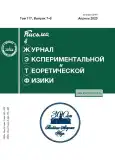Acoustic metric and Planck constants
- Authors: Volovik G.E1,2
-
Affiliations:
- Aalto University
- Landau Institute for Theoretical Physics
- Issue: Vol 117, No 7-8 (4) (2023)
- Pages: 556-557
- Section: Articles
- URL: https://journals.rcsi.science/0370-274X/article/view/145188
- DOI: https://doi.org/10.31857/S1234567823070121
- EDN: https://elibrary.ru/KLNUMV
- ID: 145188
Cite item
Full Text
Abstract
Based on Akama–Diakonov (AD) theory of emergent tetrads, it was suggested that one can introduce two Planck constants,
and
, which are the parameters of the corresponding components of Minkowski metric,
. In the Akama–Diakonov theory, the interval
is dimensionless, as a result the metric elements and thus the Planck constants have nonzero dimensions. The Planck constant
has dimension of time, and the Planck constant
has dimension of length. It is natural to compare
with the Planck length
. However, this connection remains an open question, because the microscopic (trans-Planckian) physics of the quantum vacuum is not known. Here we study this question using the effective gravity emerging for sound wave quanta (phonons) in superfluid Bose liquid, where the microscopic physics is known, and the elements of the effective acoustic metric are determined by the parameters of the Bose liquid. Since the acoustic interval is dimensionless, one may introduce the effective “acoustic Planck constants.” The acoustic Planck constant
has dimension of length and is on the order of the interatomic distance. This supports the scenario in which
. We also use the acoustic metric for consideration of dependence of
on the Hubble parameter in expanding Universe.
About the authors
G. E Volovik
Aalto University; Landau Institute for Theoretical Physics
Author for correspondence.
Email: letters@kapitza.ras.ru
References
- K. Akama, Progress of Theoretical Physics 60, 1900 (1978).
- D. Diakonov, arXiv:1109.0091.
- A. A. Vladimirov and D. Diakonov, Physics of Particles and Nuclei 45, 800 (2014).
- A. A. Vladimirov and D. Diakonov, Phys. Rev. D 86, 104019 (2012).
- Y. N. Obukhov and F. W. Hehl, Phys. Lett. B 713, 321 (2012).
- G. E. Volovik, doi: 10.13140/RG.2.2.13398.73282.
- M. Sch�onberg, Rivista Brasileira de Fisica 1, 91 (1971).
- H. Urbantke, J. Math. Phys. 25, 2321 (1984).
- R. Capovilla, J. Dell, T. Jacobson, and L. Mason, Class. Quantum Gravity 8, 41 (1991).
- Yu. N. Obukhov and S. I. Tertychniy, Class. Quantum Gravity 13, 1623 (1996).
- F. W. Hehl and Yu. N. Obukhov, Foundations of classical electrodynamics, Birkhauser, Boston (2003).
- L. Friedel and S. Speziale, SIGMA 8, 032 (2012).
- F. R. Klinkhamer and G. E. Volovik, JETP Lett. 109, 364 (2019).
- J. Nissinen and G. E. Volovik, Phys. Rev. Research 1, 023007 (2019).
- W.G. Unruh, Phys. Rev. Lett. 46, 1351 (1981).
- C. Barcelo, S. Liberati, and M. Visser, Living Rev. Relativity 14, 3 (2011).
- G.E. Volovik, JETP 132, 727 (2021).
- G.E. Volovik, JETP 135, 663 (2022).
Supplementary files










